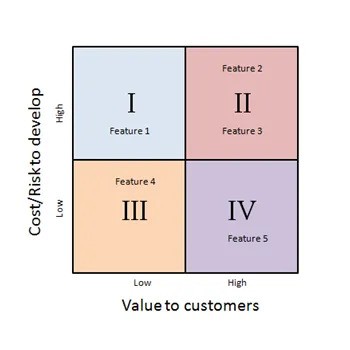
A Simple Technique for Determining Where to Focus Development Efforts for the Highest Payoff
Feature Prioritization Using the Four Quadrant Matrix
In previous articles, white papers and in my book, Expert Product Management I’ve covered how to use a feature prioritization matrix combined with techniques such as themes, golden features and timed releases to build out your product plans and determine what should be in each of your releases. Here I’ll be covering a technique called the four quadrant matrix.
Many of you are probably familiar with the Boston Consulting Group (BCG) matrix. which uses growth rates and relative market position to categorize products into cash cows, stars, dogs and question marks to determine where to invest your future resources. The four quadrant matrix uses a similar approach to help you determine where to invest you development resources to achieve maximum payoff.
The concept behind the four quadrant matrix is very simple. On the X axis you map value to the customer (which presumably correlates to increased revenues & drives customer satisfaction, upgrades and additional long-term sales). On the Y axis you put the cost/risk of developing the corresponding feature.
Using a ranking system (usually based on gut feel rather than hard quantitative data, though the more data you use the better) you can then put each of the features you are considering on the matrix to evaluate payoff versus costs.
Here’s an example of the matrix:

Note: a template for this matrix is available in the 280 Group free templates. Download the free templates here.
Completing the matrix gives you several useful results:
- You can virtually forget about all of the features in Quadrant I (unless they are a critical competitive necessity).
- You can focus on delivering the features in Quadrant IV.
- Features in Quadrant III can also likely either be discarded or noted as “Nice to Have but not critical” in your requirements documents and planning.
- Features in Quadrant II can be studied more thoroughly. Oftentimes these will be the features that provide true differentiation and a strategic competitive advantage in the long run. You’ll want to be careful not to discard them due to the risk, but you will want to choose very carefully which you decide to make “Must Have’s”.
This is obviously a simple method and isn’t without its flaws. However, when combined with the feature prioritization matrix and other techniques it can provide valuable additional insight about where to focus your efforts. It should also be noted that this can be a useful tool for both waterfall and agile development methods (though the risk in using this with Agile is that for teams short sprints you will almost always focus on Quadrant IV and Quadrant II will likely not get the investment that it needs.)


